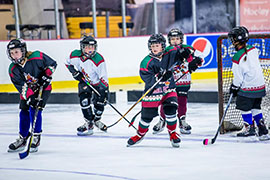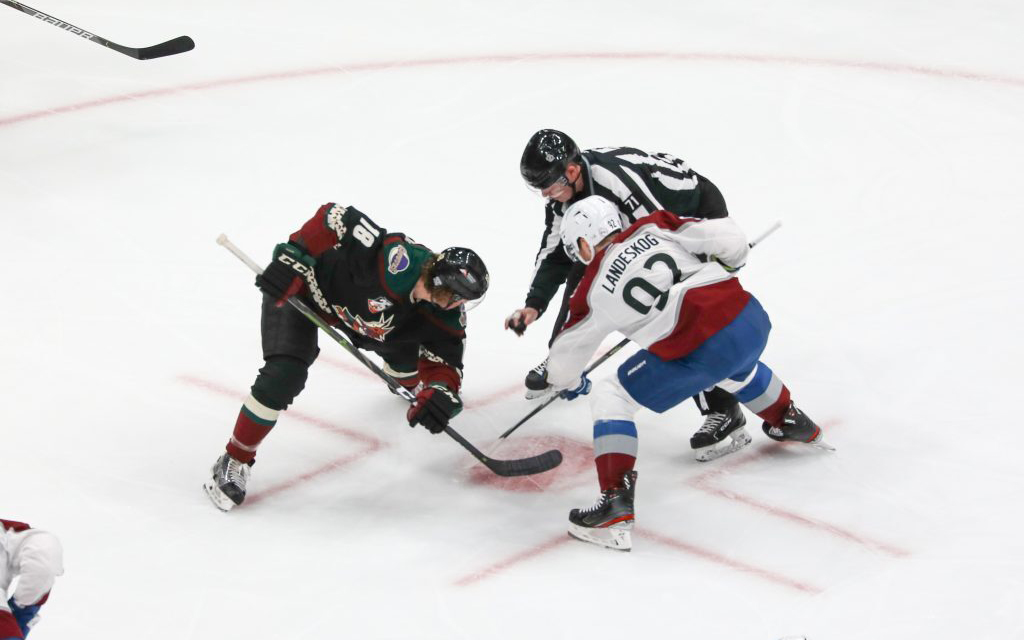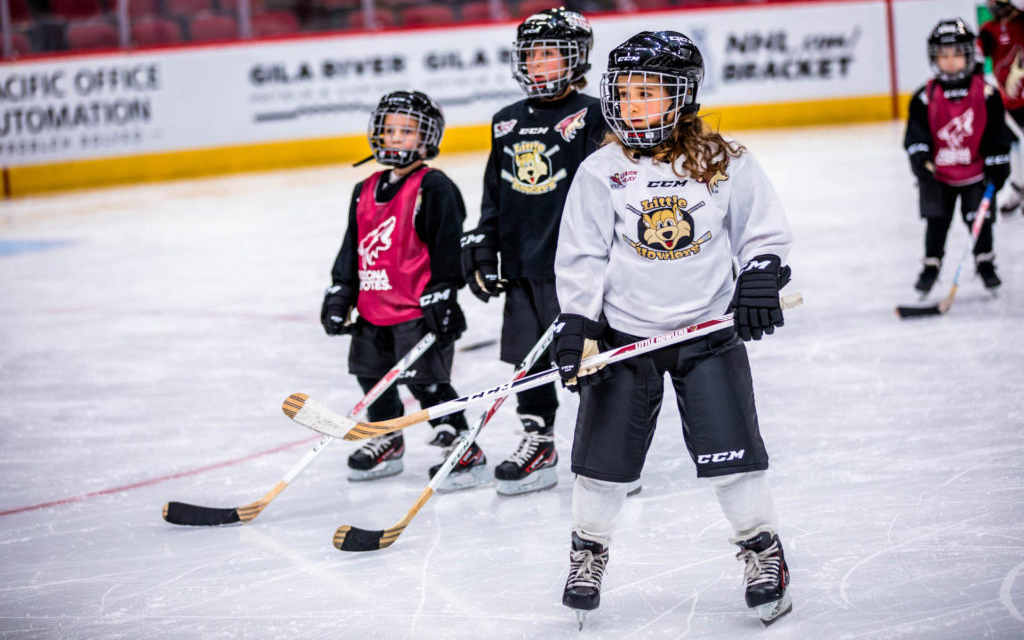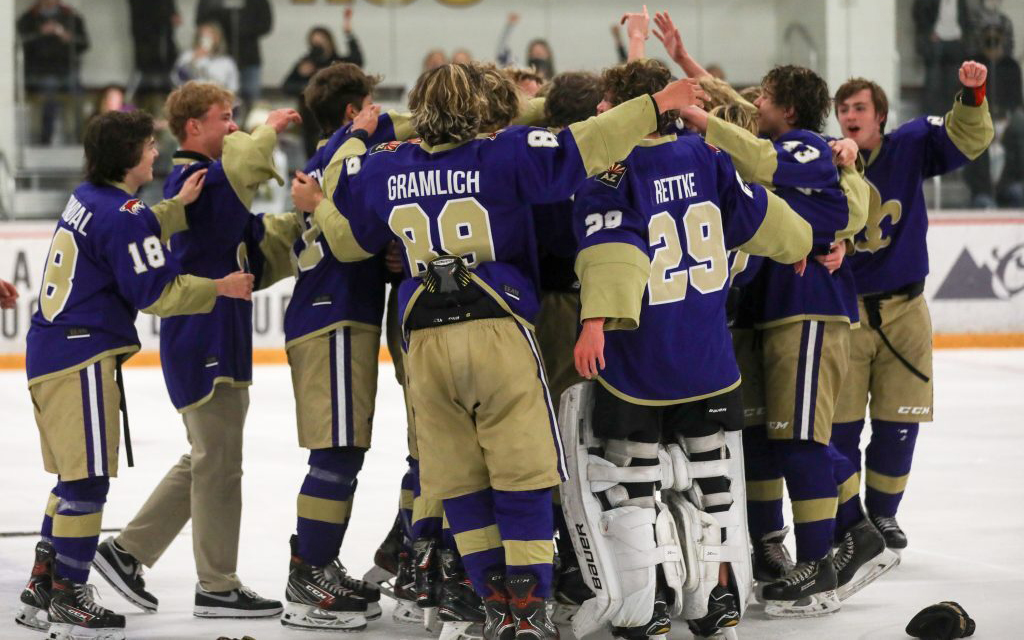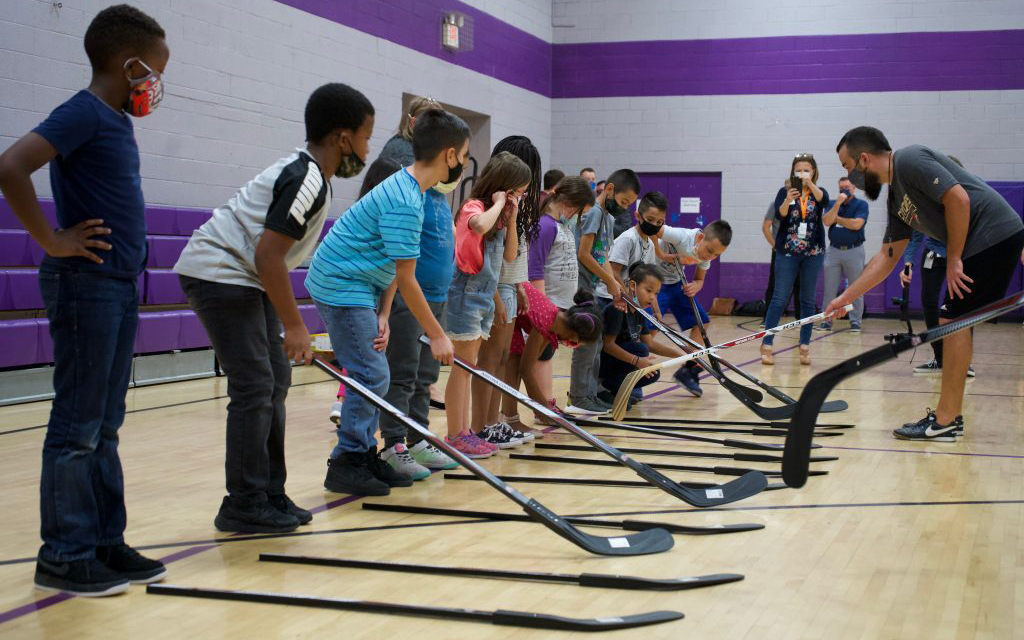- Slug: Sports-Growth Hockey Arizona,2430 words.
- 5 photos (thumbnails, captions below)
By Remy Mastey
Cronkite News
PHOENIX – Ice hockey and the desert may seem like a strange pair at first, but the sport has thrived in Arizona and reached unprecedented levels in a state known for its ice-melting climate.
Through the rise of professional, collegiate and youth hockey, Arizona has grown a robust hockey culture that rivals the best in the United States. But hockey didn’t become popular overnight in Arizona. It took decades for the sport to start spreading rapidly across the state.
“When I was growing up in Arizona, I would ask my friends to try hockey, and they would just laugh at me and say, ‘It is the wildest and weirdest sport in the world,’” said Justin Rogers, director of hockey operations with the VOSHA Titans. “So now to see this growth is unbelievable.”
How did hockey transition from a foreign game to its present-day popularity in Arizona, where kids are not only playing hockey but striving to play at the professional and collegiate levels?
‘The Coyotes definitely paved the way’
As Bobby Hull, Jean Beliveau and Gordie Howe made legendary marks over the early years of the NHL, Arizonans were unable to witness any of their greatness in the state.
But on May 16, 1967, the course of hockey in the Valley changed forever. The Western Hockey League, a major junior ice hockey league, approved moving the Victoria Maple Leafs from Victoria, Canada to Phoenix and renamed the team the Phoenix Roadrunners.
Due to financial difficulties, the Roadrunners folded in the WHL. Still, they would go on to play in the World Hockey Association, the Central Hockey League, the Pacific Hockey League and the International Hockey League.
During this time, the Roadrunners began to build a unique hockey atmosphere for players and fans.
“The fans were passionate and ruckus,” said Ron Exelby, who played goalie for the Roadrunners and owns Behind the Mask hockey shops. “When I played up in Canada and some of the minor league teams there, the fans were more critical of hockey like, ‘Wow, that guy made a bad pass or that goalie gave up a bad goal.’ Here I was just amazed that they were just happy to be at the game. There were a lot more passionate hockey fans here than people gave credit for.”
The Roadrunners attracted an average of 5,794 fans per game during the 1990-91 season. That number jumped to 7,454 fans during the team’s 1995-96 campaign. Then, after 79 years of the NHL’s existence, Arizona landed a team after the Winnipeg Jets relocated to Phoenix on July 1, 1996.
The Phoenix Coyotes were officially born.
“It didn’t cross my mind in a million years that I would end up in Phoenix,” former Coyotes captain Shane Doan said. “It was so unique. When we got down here I was blown away by the city.”
When the Coyotes arrived in the Valley, only three ice rinks had been built. As far as the number of skaters, only 2,100 people were registered as youth and adult hockey players at the time.
The Coyotes helped create positive change. By 2000, Arizona had six year-round ice skating facilities and 5,500 registered players, more than double the amount from 1996.
“Our first-month sales were only $900,” Exelby said. “The Coyotes came in and really brought a lot of notoriety to hockey. Everyone wanted a Coyotes jersey or a Coyotes hat. We kind of just grew from there and expanded. The Coyotes definitely paved the way.”
Investment in community and youth hockey
Since the Coyotes arrived in the Valley, the team has taken community investment to heart. Over the span of five years from 2013-2018, the Coyotes have donated 2,100 sets of hockey equipment to youth, adult, special needs and sled hockey programs. In addition, the franchise donated $300,000 to local rinks and more than 12,000 jerseys to hockey programs across the state.
The Coyotes’ involvement in the community led Arizona to be ranked second among NHL markets in total growth percentage over a five-year span (2014-18 seasons) and first in total percentage growth for female hockey players.
As a result of the boom and Arizona’s limited number of ice rinks, it’s not unusual for kids to run into NHL players in the Valley.
“We have such a tight-knit community,” Doan said. “In Canada, a city of 10,000 people would have around 15 to 20 ice sheets, and you could go your entire life without ever running into an NHL player. Where(as) if you go play hockey in Arizona, you will run into NHL players because in the community, there are so many NHL players at the rinks all the time.
“The kids have the opportunity to listen and see and be around NHL players. It’s become a big part of the hockey structure.”
Over the 26 years, Coyotes players have been influential to the community – and no one has been more important to this growth than Doan.
Drafted by the Jets in 1995, Doan is widely considered the best Coyotes player of all time. He played from 1996 to 2017, and became team captain in 2003 to serve not only his teammates but the entire Arizona community.
Through his work, Doan laid the blueprint for how the Coyotes should represent themselves on and off the ice.
“Shane Doan, for as long he has been here, being the face of the franchise, has been huge for Arizona,” said former ASU hockey coach Mike DeAngeles, who currently works as the director of hockey operations for the Phoenix Jr. Coyotes, a youth hockey organization. “I really think the Arizona hockey community has kind of rallied around that name as being a Coyote and remember the success the team had years ago where they made a good couple runs into the playoffs.”
After Doan’s illustrious career with the Coyotes, instead of returning to his hometown of Halkirk, Canada, he stayed in Arizona and imparted his wisdom at the junior level.
But Doan is not the only ex-NHL player continuing to get involved with hockey in the Valley. Former Coyotes players, such as Ray Whitney and Derek Morris, are involved with the Junior Coyotes.
“I think just the longer the Coyotes have been here, the more it’s grown,” ASU hockey coach Greg Powers said. “When you have the NHL in a major market, you have guys like Shane Doan, Keith Tkachuk and Jeremy Roenick, and superstars like that have played here, and that helped grow the game.
“It’s huge and then the longer it’s here, the more guys retire here, the more guys coach here, the more guys coach youth hockey. When you have really good coaching in youth hockey, you have good development and you start to see some really good players now coming out of Arizona.”
The rise of youth programs has also led to an increase in talented players from Arizona. The most prominent player to come out of Arizona is current Toronto Maple Leafs forward Auston Matthews.
Matthews grew up in Arizona and, unlike most players who seek to make the NHL, took an untraditional route by playing his childhood years in Arizona.
Growing up, Matthews played for the Jr. Coyotes and the Arizona Bobcats, another youth hockey club. Eventually, Matthews made a name for himself on to play for the U.S. national team.
Matthews was drafted by the Maple Leafs with the first overall pick in 2016, becoming Arizona’s first top selection and sparking new hope for kids striving to play hockey in the state.
“The sport of hockey really spiked again in Arizona when Auston Matthews was drafted first overall,” Rogers said. “It definitely gave every player a mindset of, it doesn’t matter if I’m from Arizona, I could still go to the NHL as well.”
During the 2015-16 NHL season, 7,510 kids from Arizona were registered with USA Hockey. By the 2017-18 season, 8,617 kids were registered.
“The Coyotes are the reason I started playing hockey,” Matthews said in an interview with Sportsnet in 2016. “We’re pretty fortunate to have them in the Valley.”
Rise of college hockey in Arizona
While the NHL may be the ultimate prize to a young hockey player, a strong collegiate hockey program is also critical in growing the sport in any state. Universities in Minnesota, Denver and Boston live and breathe college hockey, producing some top-end talent across the NHL.
In the past, Arizona State University was traditionally known for its strong football and basketball programs while the school’s hockey program was sometimes considered as an afterthought.
In the early 1980s, ASU’s ice hockey club began, and it didn’t take long to become official. ASU joined the Division II American Collegiate Hockey League and by 1996 qualified to play in the ACHA Division I tournament.
Over the years through the process, ASU started to develop as a legitimate hockey program.
“I just don’t think a lot of students at ASU knew there was a club hockey program,” DeAngeles said. “There were a lot of kids from back east and stuff, you know, who were going to ASU but didn’t really know about it or weren’t interested in it. But little by little, we actually did quite well nationally for a couple years into doing it, you know, just grew and grew and just at the talent level got better and better.”
In 2014, ASU won the ACHA Division I national championship for the first time to bring much-needed attention to the up-and-coming hockey program.
“In 2013-14 we won a national championship, which raised a lot of eyebrows and it proved to a lot of people that college hockey can work here at Arizona State,” Powers said. “It elevated the awareness of our program to a level that I don’t know anyone could have dreamed of.”
On Nov. 18, 2014, ASU Vice President for University Athletics Ray Anderson announced that the school would move its hockey program to Division I. Two years later, ASU played its first full season in Division I but didn’t blossom into a true contender until the 2018-19 season with a 21-13-1 record to earn the program’s first NCAA tournament appearance.
Led by Powers, the ASU hockey program is starting to gain recognition nationally. On this year’s Sun Devils roster, there are 26 out-of-state players.
High-caliber players born and raised in Arizona are also deciding to stay home to play college hockey at ASU, including NHL prospects Josh Doan, a second-round pick by the Coyotes in the 2021 NHL draft, and Demetrious Koumontzis, a fourth-round pick by the Calgary Flames in the 2018 draft.
“I think any chance you have to stay home and play Division I in front of your friends and family, it’s an opportunity you have to take,” Josh said. “Building hockey in the desert is something that my family has been keen on throughout my whole life and just making sure Arizona stays in a place where hockey can thrive.
“What better way to do that than to stay home in a program that is slowly starting to build and obviously what they have been able to do now, there is no school in the country better than them. They are competing with everybody and to be a part of that is huge.”
The Sun Devils have sent off an astonishing 23 players to play professional hockey, including the NHL’s Joey Daccord and Brinson Pasichnuk. Six ASU graduates from the 2021-22 team currently play professionally.
All these ASU hockey legends played at Oceanside arena, a place the Sun Devils called home for many years. Following the conclusion of the 2021-22 season, ASU closed their long rich history at Oceanside and officially moved into the newly built Mullett Arena.
With the ASU hockey program achieving success nobody could have expected, the bar needed to be raised. Mullett Arena is a 5,000-seat state-of-the-art arena that puts the program in another stratosphere.
“I think it just validates our program and solidifies where we’re at and how attractive we are, not only for players that want to come play here but for kids and families to come and watch games in such a great environment and see such high-level hockey here locally,” Powers said.
During the 2021-22 season at Oceanside, the Sun Devils averaged 721 fans per game due to limited seats in the arena. At Mullett Arena this season, the Sun Devils have averaged roughly 4,300 fans per game, a huge increase from previous years.
Fans can not only watch the Sun Devils play at Mullett Arena, but the Coyotes signed a contract to play at the unofficial mecca of hockey for the next three seasons with an optional fourth year if both parties agree.
“I think we’re an attainable light for kids to reach and want to be a part of one day,” Powers said. “The NHL certainly is a dream, but it’s a pipe dream for 99% of the kids that put on skates, but in Division I hockey you can do it. So when kids come here that play locally and they watch us play in front of 5,000 people in a beautiful arena against teams like Minnesota, we want them to grow up longing and dreaming to be Sun Devils.”
ASU might be the largest college hockey program in Arizona, but Grand Canyon University started a club in 2016, and the University of Arizona boasts a team that has made the ACHA National Tournament five times in the last eight years. The Wildcats, who won the Western Collegiate Hockey championship in 2019 and 2020, plan to build a new 3,000-seat arena for the men’s and women’s hockey programs by 2024.
“It’s been such an amazing transformation,” DeAngeles said. “Hockey in the Southwest United States is something I have always dreamt of happening and now it’s here.”
And hockey doesn’t appear to be going anywhere anytime soon. The state can compete with other top hockey towns across the country, whether at the professional, college or youth level.
“Stay home and stay in Arizona to develop,” Josh said. “If you’re good enough, scouts are going to find you at some point down the road no matter where you play. You don’t have to go to Minnesota or Michigan at a young age to hope that five years down the road you’re going to get scouted.
It goes to show the growth of Arizona hockey and what some of these younger kids are doing now and staying here. It’s something I hope other kids down the road are going to do, stay local and continue to produce prospects out of here for years to come.”
For more stories from Cronkite News, visit cronkitenews.azpbs.org.
^__=
During the 2015-16 NHL season, 7,510 kids from Arizona were registered with USA Hockey. By the 2017-18 season, that number increased to 8,617, and the drafting of the Valley’s Auston Matthews by the Toronto Maple Leafs in 2016 is believed to have contributed to that. (Photo courtesy of Arizona Coyotes)
Since the Coyotes arrived in the Valley, the team has taken community investment to heart, and in a recent five-year span donated 2,100 sets of hockey equipment to youth, adult, special needs and sled hockey programs. (File photo by Alina Nelson/Cronkite News)
The rise of youth programs has also led to an increase in talented players from Arizona and more demand for ice time. (Photo courtesy of Arizona Coyotes)
Even though hockey is not sanctioned by the Arizona Interscholastic Association, schools including Notre Dame Prep are still able to earn a state title through the Arizona High School Hockey Association. (File photo by Alina Nelson/Cronkite News)
The Coyotes are determined to continue the growth of youth hockey, often putting on clinics for the community. (File photo by Jake Santos/Cronkite News)
